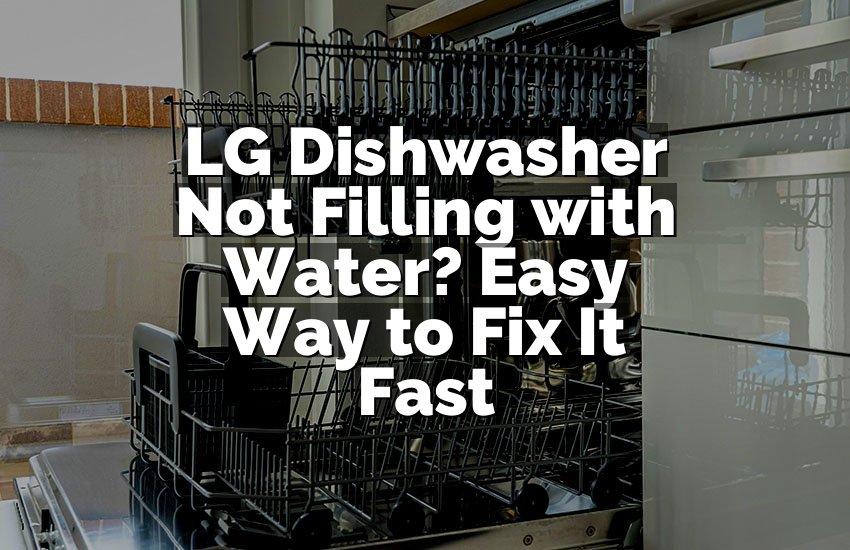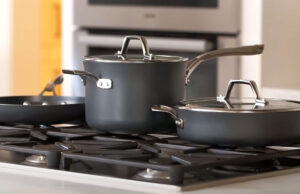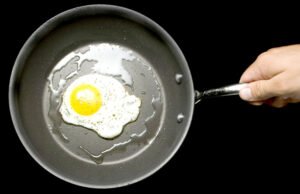As an Amazon Associate, I earn from qualifying purchases at no extra cost to you.
LG Dishwasher Fault Code AE: Easy Way to Fix It Fast
Are you frustrated by your LG dishwasher showing the AE fault code? Don’t panic! This guide will help you understand what it means and how to fix it quickly.
The LG dishwasher AE fault code usually means a problem with water leakage. It can be caused by blocked drains, faulty sensors, or water pressure issues. Checking hoses, cleaning filters, and inspecting the float switch can often solve it.
Knowing this will save you money and prevent damage. Always unplug your dishwasher before working on it, and carefully follow each step to fix the issue safely. Small, simple actions often fix the problem without professional help.
Steps to Fix Your LG Dishwasher Fault Code AE
Check for Water Leakage
Water leakage is the most common reason for the AE error. First, look under the dishwasher for visible water. Even small amounts can trigger the code. Use a towel to dry the base and check hoses for cracks or loose connections. Make sure the drain hose is properly attached and not bent. If you find a leak, tighten connections or replace damaged hoses immediately.
Next, check the water inlet valve. Sometimes it leaks slowly, causing the AE error. Inspect the valve for water stains or damp areas. If it looks damaged, replace it. Also, make sure the door seal is clean and intact. Any gap can let water escape. Regularly cleaning the seal with a soft cloth prevents buildup.
Finally, test your dishwasher after fixing leaks. Run a short cycle and watch for the AE code. If it comes back, there may be a sensor issue. Otherwise, you solved the problem. Fixing leaks early avoids serious water damage in your kitchen.
- Check under the dishwasher for water
- Inspect hoses and tighten connections
- Check inlet valve for leaks
- Clean and inspect door seal
- Run a test cycle
Inspect the Float Switch
The float switch senses water levels in the dishwasher. If it’s stuck or dirty, the AE code appears. Open the bottom panel and locate the float switch. Gently move it up and down. If it doesn’t move freely, clean it carefully. Sometimes debris blocks its movement.
After cleaning, test the float switch with a multimeter for continuity. If it fails, replace it. A faulty switch will not detect water correctly, triggering the AE error. Using the correct replacement ensures your dishwasher works safely. Always turn off power before testing electrical parts.
Next, check the float housing for cracks. Water can leak inside, causing errors. Replace any damaged parts promptly. Finally, reassemble the bottom panel and test a wash cycle. The AE code should disappear if the float switch was the issue.
- Locate and move float switch
- Clean any debris blocking movement
- Test with a multimeter
- Inspect float housing for cracks
- Reassemble and run test cycle
Clean and Check Filters
Clogged filters can cause water to overflow, triggering the AE code. Remove the dishwasher filter and rinse it under running water. Make sure no food or debris blocks the mesh. Even small particles can affect water flow. Clean regularly to prevent future problems.
Next, check the spray arms for clogs. Remove them and rinse thoroughly. Use a toothpick or small brush to remove stuck debris. Proper water flow is critical for dishwasher operation. Dirty spray arms can also cause leaks that lead to the AE error.
Finally, inspect the drain pump filter. It often collects dirt and small pieces of glass. Carefully clean it and ensure it spins freely. Replace any damaged filters immediately. Test the dishwasher after cleaning to ensure smooth operation and no AE code.
- Remove and clean dishwasher filter
- Clean spray arms thoroughly
- Inspect drain pump filter
- Remove debris blocking water flow
- Run a test cycle
Examine the Drain Hose
The drain hose can be blocked or bent, causing water to back up. Check the hose for kinks or sharp bends. Straighten it out to allow proper drainage. Inspect the connections at both ends for leaks. Tighten clamps if needed.
Next, remove the hose and flush it with water. Use a long brush to remove stubborn debris inside. Any blockage can cause water to accumulate and trigger the AE code. Inspect the end of the hose for buildup. Cleaning regularly prevents recurring issues.
After cleaning, reattach the hose securely. Run a cycle and monitor the dishwasher. If water drains properly and AE code is gone, the problem is solved. Regular maintenance of hoses prevents expensive repairs later.
- Check hose for kinks or bends
- Tighten connections and clamps
- Flush hose with water
- Remove internal debris
- Test dishwasher
Inspect Water Pressure
Incorrect water pressure may trigger AE errors. Low pressure can prevent proper filling, while high pressure may cause leaks. Check the water supply valve and make sure it is fully open. Measure pressure with a gauge if necessary.
Next, inspect the inlet hose for blockages. Remove it and flush water through to ensure flow is smooth. If the pressure is too low, clean or replace the inlet valve. High pressure may need a regulator to prevent leaks. Always use proper parts for replacement.
After adjusting water pressure, run a test cycle. Watch for AE code. Correct pressure ensures your dishwasher fills and drains correctly. Maintaining it improves cleaning performance and prevents leaks.
- Check water supply valve
- Measure water pressure
- Inspect and flush inlet hose
- Replace or adjust valve if needed
- Test dishwasher
Reset the Dishwasher
Sometimes, resetting the dishwasher clears the AE code. Turn off power for at least 5 minutes. Unplug or switch off the circuit breaker. This allows the control board to reset.
Next, plug the dishwasher back in and start a short cycle. Watch for any error codes. If the AE code returns, further troubleshooting is needed. Resetting often solves minor electronic glitches without repairs. It’s an easy first step before more complex checks.
- Turn off power completely
- Wait at least 5 minutes
- Plug back in and start cycle
- Monitor for AE code
- Repeat reset if necessary
| Component | Common Issue | Solution | Notes |
|---|---|---|---|
| Hoses | Kinks, leaks | Tighten, replace | Check both ends |
| Float Switch | Stuck, dirty | Clean, replace | Test with multimeter |
| Filters | Clogged | Rinse, remove debris | Clean regularly |
| Drain Pump | Blocked | Clean | Ensure free rotation |
| Water Pressure | Low/high | Adjust, replace valve | Check supply |
| Door Seal | Worn | Replace | Prevent leaks |
Why AE Code Appears Frequently
The AE error can come from many small issues. Over time, hoses loosen, filters clog, and water sensors fail. Regular inspection prevents this. A small leak or dirty component can trigger the code even if the dishwasher seems fine.
Additionally, using hard water increases deposits, which may affect sensors and float switches. Cleaning with vinegar or descaler monthly helps. It prevents the buildup that can cause AE errors. Proper maintenance keeps the dishwasher running smoothly for years.
Check connections, hoses, and filters after each few months. This reduces the chance of AE code appearing unexpectedly. Sometimes the AE code is a warning for future damage. Taking action quickly avoids expensive repairs or water damage.
- Inspect hoses and filters regularly
- Clean sensors and float switches
- Use water softeners if needed
- Monitor dishwasher after cycles
- Take action early
How to Maintain LG Dishwasher
Maintaining your dishwasher prevents AE codes. First, clean filters and spray arms monthly. Small debris or hard water deposits reduce efficiency. Check hoses for leaks and tighten connections regularly. Clean the door seal to prevent water escaping.
Next, check the float switch periodically. Move it gently and clean around it. Inspect for cracks or damage in water hoses. Replace damaged parts immediately. Run a cleaning cycle with dishwasher cleaner once a month.
Also, check water pressure. Ensure supply valves are fully open and no blockages exist. Using proper detergents prevents residue buildup. Following these steps increases lifespan and reduces AE errors. Your dishwasher will stay reliable for years with simple maintenance.
- Clean filters and spray arms monthly
- Inspect float switch and hoses
- Run cleaning cycles
- Check water pressure
- Use proper detergents
Common Mistakes People Make
Many people ignore small leaks or clogged filters. Waiting too long often causes AE codes. Using excessive detergent or dishwasher tablets can also cause overflow issues. Hard water buildup is another common mistake.
Some try to reset repeatedly without checking actual problems. While resets may help temporarily, underlying issues persist. Inspecting hoses, filters, and float switches first saves time and money. Proper care prevents repeated AE codes. Simple preventive steps are always better than emergency fixes.
- Ignore leaks or clogs
- Overuse detergent
- Skip filter cleaning
- Delay inspections
- Rely on resets only
Troubleshooting Without a Technician
You don’t always need a professional. Checking hoses, float switch, filters, and water pressure solves most AE codes. Simple cleaning and adjustments often fix the issue. Keep a flashlight, small brush, and multimeter handy.
Document what you inspect and replace. Step-by-step checks prevent mistakes. If problems persist after cleaning, resetting, and adjusting, contact a certified technician. Early troubleshooting can avoid major repairs and water damage.
- Inspect hoses, float switch, and filters
- Adjust water pressure
- Clean and reset
- Keep track of work done
- Call technician if needed
Frequently Asked Questions (FAQs)
Is it dangerous to ignore AE code?
Ignoring the AE code can lead to water leaks inside your kitchen. The dishwasher may overflow, causing damage to cabinets and flooring. The code warns you about possible leaks. Acting early prevents expensive repairs and avoids electrical hazards.
Can I fix AE code myself?
Yes, most AE codes are caused by leaks, clogged filters, or faulty float switches. Checking hoses, cleaning filters, and inspecting the float switch usually solves the issue. Always unplug the dishwasher before working on it for safety.
Do I need special tools for fixing AE?
You don’t need many special tools. A small brush, screwdriver, towel, and optionally a multimeter are enough. These help clean, tighten, and check components safely. Avoid using harsh chemicals that may damage parts.
Is it common for LG dishwashers to show AE?
Yes, AE is a common error, usually indicating a leak or water level issue. Regular maintenance reduces occurrences. It’s a warning, not a critical failure, so addressing it early prevents bigger problems.
Can hard water cause AE code?
Yes, hard water can create mineral buildup in sensors and hoses. This may trigger the AE code. Using a water softener or cleaning with vinegar helps prevent buildup. Regular cleaning is key to avoid repeated errors.
Do I have to replace the float switch?
Not always. Sometimes cleaning the float switch resolves the AE code. Only replace it if it’s stuck, cracked, or fails continuity tests. Correct replacement ensures proper water level detection.
Is resetting dishwasher effective?
Resetting can clear minor glitches but won’t fix leaks or blockages. Turn off power for at least 5 minutes and restart. If AE code persists, inspect hoses, filters, and float switch. Reset is a first, quick solution.
Can clogged filters trigger AE?
Absolutely. Clogged filters block water flow, causing overflows and AE errors. Clean filters regularly. Check spray arms and drain pump filter for debris to maintain proper water circulation.
Final Thoughts
Fixing the LG dishwasher AE code doesn’t have to be stressful. Most problems are simple, like leaks, blocked filters, or float switch issues. By inspecting, cleaning, and maintaining your dishwasher, you save money and avoid future damage. A little care goes a long way for smooth, error-free operation.





